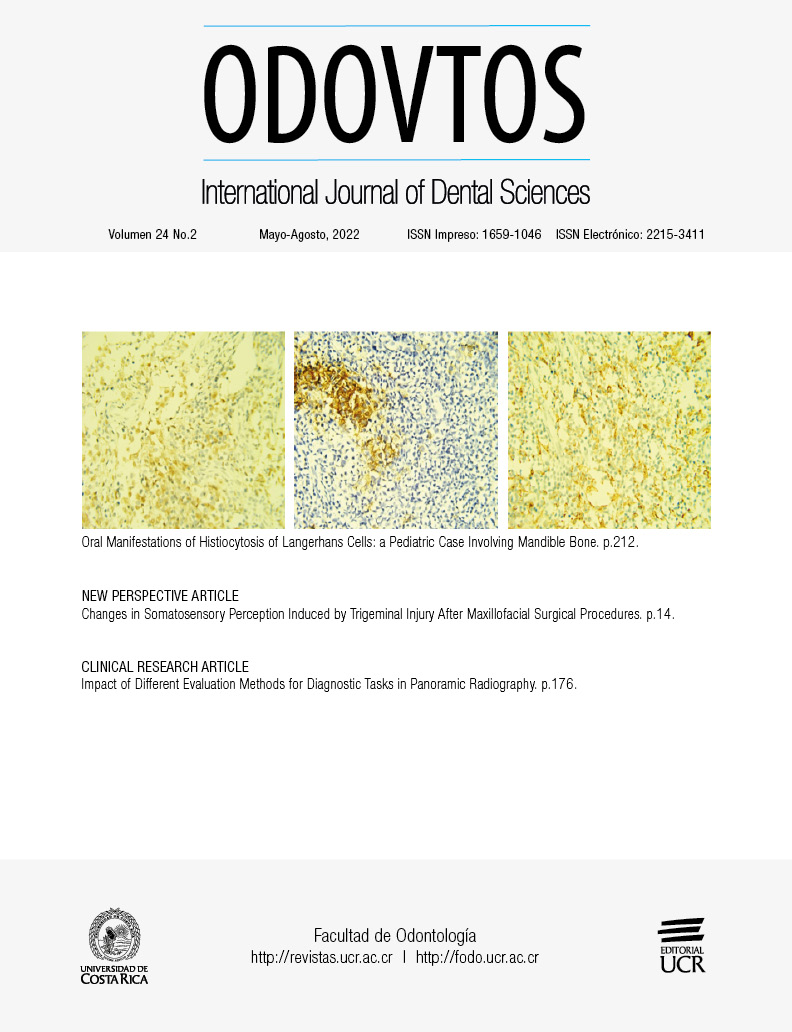Resumen
El síndrome de Eagle es una enfermedad rara responsable de múltiples síntomas de cabeza y cuello, resultado de un alargamiento del proceso estiloideo u osificación del ligamento estilohioideo comprimiendo estructuras neurovasculares adyacentes, hay dos variantes, el clásico caracterizado principalmente por dolor y disfagia y la variante carotídea distinguido con dolor y en ocasiones isquemia cerebral.
Describimos un reporte de caso clínico de un paciente femenino de 45 años, quien experimentaba dolor cervical de lado izquierdo, realizando el protocolo completo de dolor miofascial del Hospital Regional “General Ignacio Zaragoza” ISSSTE de la Ciudad de México, el estudio de tomografía computada evidenció una elongación de 50 mm del proceso estiloideo, confirmando el diagnóstico, enfocando el artículo en la descripción anatómico-quirúrgica.
Citas
Oueslati S., Douira W., Dhieb R., Ben Farhat L., Mnif N., Rezgui L., et al. Le syndrome de Eagle. Ann d’Oto-Laryngologie Chir Cervico-Faciale. 2006; 123, 3, 152-156. https://doi.org/10.1016/s0003-438x (06) 76657-9.
Bouguila J., Khonsari R.H., Pierrefeu A., Corre P. Eagle syndrome: A rare and atypical pain! Revue de Stomatologie et de Chirurgie Maxillo-Faciale. 2011; 112 (6): 348-352. https://doi.org/ 10.1016/j.stomax.2011.08.007.
Müderris T., Bercin S., Sevil E., Beton S., Kiris M. Surgical management of elongated styloid process: Intraoral or transcervical? Eur Arch Oto-Rhino-Laryngology. 2014; 271: 1709-1713. https://doi.org/10.1007/s00405-013-2664-0.
Naik S.M., Naik S.S. Tonsillo-styloidectomy for Eagle’s syndrome: A review of 15 cases in KVG Medical College Sullia. Oman Med J. 2011; 26 (2): 122-126. https://doi.org/10.5001/omj.2011.30.
Fusco D.J., Asteraki S., Spetzl R.F. Eagle’s syndrome: Embryology, anatomy, and clinical management. Acta Neurochirurgica. 2012; 154 (7): 1119-1126. https://doi.org/10.1007/s00701-012-1385-2.
Badhey A., Jategaonkar A., Anglin Kovacs A.J., Kadakia S., De Deyn P.P., Ducic Y., et al. Eagle syndrome: A comprehensive review. Clinical Neurology and Neurosurgery. 2017; 159: 34-38. https://doi.org/10.1016/j.clineuro.2017.04.021.
Eagle W.W. Elongated Styloid Processes: Report of Two Cases. Arch Otolaryngol - Head Neck Surg. 1937; 25(5):584-587. https://doi.org/ 10.1001/archotol.1937.00650010656008.
Lorman J.G., Biggs J.R. The eagle syndrome. Am J Roentgenol. 1983; 140 (5): 881-882. https://doi.org/10.2214/ajr.140.5.881.
Kawasaki M., Hatashima S., Matsuda T. Non-surgical therapy for bilateral glossopharyngeal neuralgia caused by Eagle’s syndrome, diagnosed by three-dimensional computed tomography: A case report. J Anesth. 2012; 26 (6): 918-921. https://doi.org/10.1007/s00540-012-1437-z.
EAGLE W.W. Symptomatic elongated styloid process; report of two cases of styloid process-carotid artery syndrome with operation. Arch Otolaryngol. 1949; 49 (5): 490-503. https://doi.org/10.1001/archotol.1949.03760110046003.
Eagle W.W. Elongated Styloid Process: Symptoms and Treatment. AMA Arch Otolaryngol. 1958; 67 (2): 172-176. https://doi.org/10.1001/archotol.1958.00730010178007.
Raina D., Gothi R., Rajan S. Eagle syndrome. Indian J Radiol Imaging. 2009; 19: 107-8. https://doi.org/10.4103/0971-3026.50826.
Costantinides F., Vidoni G., Bodin C., Di Lenarda R. Eagle’s syndrome: signs and symptoms. Cranio : the journal of craniomandibular practice. 2013; 31 (1): 56-60. https://doi.org/10.1179/crn.2013.008.
Correll R.W., Jensen J.L., Taylor J.B., Rhyne RR. Mineralization of the stylohyoid-stylomandibular ligament complex. A radiographic incidence study. Oral Surgery, Oral Med Oral Pathol. 1979; 48 (4): 286-291. https://doi.org/10.1016/0030-4220(79)90025-2.
Monsour P.A., Young W.G. Variability of the styloid process and stylohyoid ligament in panoramic radiographs. Oral Surgery, Oral Med Oral Pathol. 1986; 61 (5): 522-526. https://doi.org/10.1016/0030-4220(86)90399-3.
Montalbetti L., Ferrandi D., Pergami P., Savoldi F. Elongated styloid process and Eagle’s syndrome. Cephalalgia. 1995; 15 (2): 80-93. https://doi.org/10.1046/j.1468-2982.1995.015002080.x.
Mann A., Kujath S., Friedell M.L., Hardouin S., Wood C., Carter R., et al. Eagle Syndrome Presenting after Blunt Trauma. Ann Vasc Surg. 2017; Apr; 40: 295.e5-295.e8. https://doi.org/10.1016/j.avsg.2016.07.077
Langlais R.P., Miles D.A., Van Dis M.L. Elongated and mineralized stylohyoid ligament complex: A proposed classification and report of a case of Eagle’s syndrome. Oral Surgery, Oral Med Oral Pathol. 1986; 61 (5): 527-532. https://doi.org/10.1016/0030-4220(86)90400-7.
Loeser L.H., Cardwell E.P. Elongated Styloid Process: A Cause of Glossopharyngeal Neuralgia. Arch Otolaryngol - Head Neck Surg. 1942; 36 (2): 198-202. https://doi.org/10.1001/archotol.1942.03760020034003.
Pigache P., Fontaine C., Ferri J., Raoul G. Transcervical styloidectomy in Eagle’s syndrome. Eur Ann Otorhinolaryngol Head Neck Dis. 2018; 135 (6): 433-436. https://doi.org/10.1016/j.anorl.2018.05.001.

